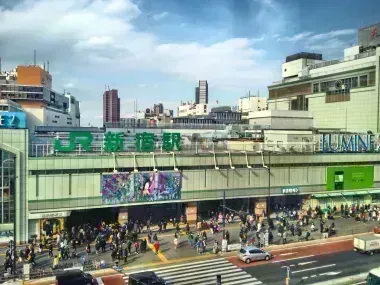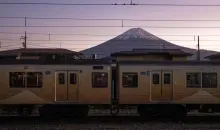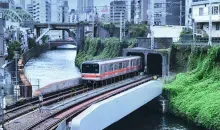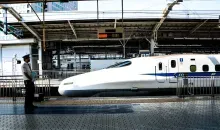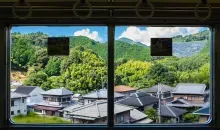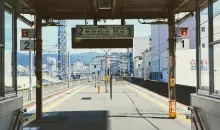Viaje en tren en Japón
En Japón, el tren es más que un medio de transporte. A continuación, ¡te dejamos los mejores consejos para viajar en tren y aprovechar al máximo tu viaje!
Los trenes en Japón forman parte de su cultura y ocupan un lugar especial en la vida cotidiana. Por ello, aquí encontrarás nuestros consejos sobre cómo viajar con facilidad durante tu visita a la isla milenaria. ¡Súbete a bordo!
Las estaciones de tren en países extranjeros a veces pueden intimidarnos, ¡pero no temas! Nuestras recomendaciones para viajar fácilmente harán que tu viaje por Japón sea sencillo. Adquiere tu Japan Rail Pass para acceder a la excepcional red de trenes sin dificultades. Además, Japón ha introducido el sistema de tarjetas IC Card, un complemento perfecto para tu Japan Rail Pass.

Shinkansen Bullet Train in Japan
@Wikimedia
Tomar el tren en Japón
Tipos de trenes en Japón
Los trenes en Japón tienen muchas formas y diseños, adaptados a fines específicos y distancias recorridas. A continuación se enumeran los tipos de trenes que los viajeros pueden ver durante su estancia en Japón:
- Tren bala Shinkansen:
- Como ya se ha mencionado, los trenes bala Shinkansen son trenes de alta velocidad utilizados principalmente para recorrer distancias más largas en Japón. Se inauguraron en 1964, antes de los Juegos Olímpicos de Tokio, y fueron los primeros de su clase en aquella época. A menudo se les cita como el símbolo del transporte público japonés en su conjunto, sentando las bases de los sistemas ferroviarios de alta velocidad en todo el mundo. Son fácilmente accesibles, rápidos y cómodos, lo que los convierte en una opción popular para viajeros y residentes de Japón en su conjunto. Todos ellos están operados por Japan Railways, por lo que se puede acceder a ellos con el Japan Rail Pass.
- Trenes exprés limitados:
- También pensados para largas distancias pero que no operan a la misma velocidad o ingeniería que los trenes bala Shinkansen de alta velocidad, estos trenes exprés limitados se utilizan a menudo entre destinos a los que no llega el Shinkansen. Algunos ejemplos son el tren expreso limitado Thunderbird, que conecta Kansai, Kanzazawa y Wakuraonsen en la prefectura de Ishikawa, y el tren expreso limitado Romance Car, operado por Odakyu, que conecta la estación de Shinjuku en Tokio con la región de Hakone en la prefectura de Kanagawa. Aunque no circulan a la misma velocidad que los trenes bala Shinkansen, los trenes exprés limitados suelen tener costes medios más bajos y también están disponibles con el Japan Rail Pass.
- Trenes de cercanías:
- Son trenes más convencionales que prestan servicio en zonas locales y ciudades. Tienen tarifas más estándar y se pueden tomar con tarjetas IC especializadas, billetes individuales y pases de un día. Por estos trenes viajan literalmente millones de personas cada día en Japón y a menudo se utilizan junto con los autobuses locales como sustituto completo del coche para desplazarse por las grandes ciudades. Japón es un país con una población elevada pero una geografía reducida, lo que hace que estos trenes estén bastante abarrotados en las horas punta. Aunque esto forma parte de su encanto, es algo a tener en cuenta a la hora de viajar. En grandes ciudades como Tokio, Osaka y Fukuoka, muchos de estos trenes locales son operados por Japan Railways y, por tanto, son accesibles con un Japan Rail Pass. Otros, sin embargo, forman parte del sistema de metro. Todas estas líneas de tren pueden recorrerse con una tarjeta IC, pero el JR Pass sólo se aplica a las líneas JR, como la Yamanote Line en Tokio y la Loop Line en Osaka. El metro y las líneas subterráneas suelen tener pases de un día especializados para uso ilimitado que merece la pena consultar.






El sistema ferroviario en Japón
Aunque viajar en tren en sí mismo es algo que no necesita demasiadas explicaciones, el sistema ferroviario utilizado en Japón puede no ser comprendido por los visitantes extranjeros. Veamos algunas cosas a tener en cuenta sobre el sistema ferroviario en Japón y consejos para desplazarse.
Un aspecto importante a tener en cuenta sobre los trenes en Japón es el tamaño de las estaciones de ferrocarril, especialmente en las grandes ciudades como Tokio y Osaka. Estaciones como Shibuya Station, Shinjuku Station, Tokyo Station, Umeda Station y Shin-Osaka Station actúan como centros comerciales tanto como estaciones de tren, ya que cuentan con restaurantes, centros comerciales y oficinas en su interior, además de dar servicio a múltiples líneas de tren. Lo mejor para no perderse en el laberinto de estas grandes estaciones de ferrocarril es conocer bien la ruta y seguir las señales del interior.
Las líneas de ferrocarril local en Japón se identifican por un logotipo cuadrado o redondo con la inicial de una letra. Las líneas JR empiezan siempre por J (JY para Yamanote, JC para Chuo Line, etc.). El logotipo y el nombre de estas líneas aparecen en carteles dentro de las estaciones con flechas que indican la dirección de las entradas y salidas. Al llegar a una estación determinada, conviene tener en cuenta las líneas que se van a recorrer y los transbordos que se harán por el camino.
Si utiliza Google Maps, Navitime, Jorudan u otras aplicaciones de navegación, obtendrá información sobre las vías a las que debe llegar e incluso la salida más cercana a su destino final. En la vía, los trenes están marcados con la dirección en la que se dirigen (a menudo el destino final o una estación importante del trayecto). Asegúrese de prestar atención a la dirección en la que se dirige en estos trenes.
El interior de los trenes varía según el tipo de tren, teniendo los trenes Shinkansen y Limited Express más comodidades que los trenes locales. Los trenes bala Shinkansen disponen de enchufes y sillas reclinables, ya que están pensados para viajes de larga distancia.
Los trenes en Japón no funcionan las 24 horas del día, así que preste atención a las salidas de los primeros y últimos trenes. Esto se aplica tanto a los trenes locales como a los de alta velocidad, así que preste atención a los horarios de los trenes; de lo contrario, tendrá que tomar el primer tren a casa o coger un taxi (que son lamentablemente caros en Japón).
Reserva de asientos para los trenes
En los trenes bala Shinkansen y los trenes Limited Express, los asientos se pueden reservar con antelación, y esta opción es muy recomendable durante las horas punta. Para los usuarios del Japan Rail Pass, estas reservas se pueden hacer sin cargo adicional, pero para los que compran billetes individuales para viajar en tren, hay un cargo adicional. Las personas con equipaje de gran tamaño (más de 160 cm en total) deben utilizar la zona de almacenamiento de equipaje de gran tamaño situada en la parte trasera del vagón. Estas zonas deben reservarse, junto con un asiento cercano, así que asegúrese de familiarizarse con estas normas.

